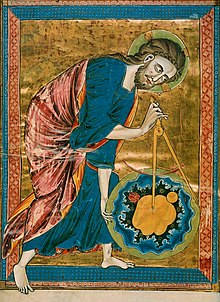
In some medieval illustrations, the compass was used as a symbol of God’s act of creation
A compass or pair of compasses is a technical drawing instrument that can be used for inscribing circles or arcs. As dividers, they can also be used as a tool to measure distances, in particular on maps. Compasses can be used for mathematics, drafting, navigation, and other purposes.
Compasses are usually made of metal, and consist of two parts connected by a hinge which can be adjusted. Typically one part has a spike at its end, and the other part a pencil, or sometimes a pen. Circles can be made by fastening one leg of the compasses into the paper with the spike, putting the pencil on the paper, and moving the pencil around while keeping the hinge on the same angle. The radius of the circle can be adjusted by changing the angle of the hinge.
Distances can be measured on a map using compasses with two spikes, also called a dividing compass. The hinge is set in such a way that the distance between the spikes on the map represents a certain distance in reality, and by measuring how many times the compasses fit between two points on the map the distance between those points can be calculated.
Compass and straightedge construction is used to illustrate principles of plane geometry. Although a real pair of compasses is used to draft visible illustrations, the ideal compass used in proofs is an abstract creator of perfect circles. The most rigorous definition of this abstract tool is the “collapsing compass”; having drawn a circle from a given point with a given radius, it disappears; it cannot simply be moved to another point and used to draw another circle of equal radius (unlike a real pair of compasses). Euclid showed in his second proposition (Book I of the Elements) that such a collapsing compass could be used to transfer a distance, proving that a collapsing compass could do anything a real compass can do.
Contents |
Variants
Beam compass is an instrument with a wooden or brass beam and sliding sockets, or cursors, for drawing and dividing circles larger than those made by a regular pair of compasses.[1]
Scribe-compass [2] is an instrument used by carpenters and other tradesmen. Some compasses can be used to scribe circles, bisect angles and in this case to trace a line. It is the compass in the most simple form. Both branches are crimped metal. One branch has a pencil sleeve while the other branch is crimped with a fine point protruding from the end. The wing nut serves two purposes, first it tightens the pencil and secondly it locks in the desired distance when the wing nut is turned clockwise.
Loose leg wing dividers [3] are made of all forged steel. The pencil holder, thumb screws, brass pivot and branches are all well built. They are used for scribing circles and stepping off repetitive measurements [4] with some accuracy.
As a symbol
A compass is often used as a symbol of precision and discernment. As such it finds a place in logos and symbols such as the Freemasons‘ Square and Compasses and in various computer icons. John Donne uses the compass as a conceit in “A Valediction: Forbidding Mourning” (1611).
-
A compass on the Coat of Arms of East Germany (German Democratic Republic)
See also
- Masonic Square and Compasses
- dividers
- Circle
References
- ^
 This article incorporates content from the 1728 Cyclopaedia, a publication in the public domain.
This article incorporates content from the 1728 Cyclopaedia, a publication in the public domain. - ^ Fine Woodworking, Build a Fireplace Mantel, Mario Rodriquez, pgs. 73, 75, The Taunton Press, No. 184, June 2006
- ^ The Carpenter’s Manifesto, Jeffrey Ehrlich & Marc Mannheimer, Holt, Rhinehart & Winston, pg. 64, 1977
- ^ Fine Woodworking, Laying out dovetails, Chris Gochnour, pg. 31, The Taunton Press, No. 190, April 2007
External links
| Wikimedia Commonshas media related to: |
- beam or trammel compass (variant form)
This information originally retrieved from http://en.wikipedia.org/wiki/Compass_(drafting)
on Wednesday 27th July 2011 1:17 pm EDT
Now edited and maintained by ManufacturingET.org







